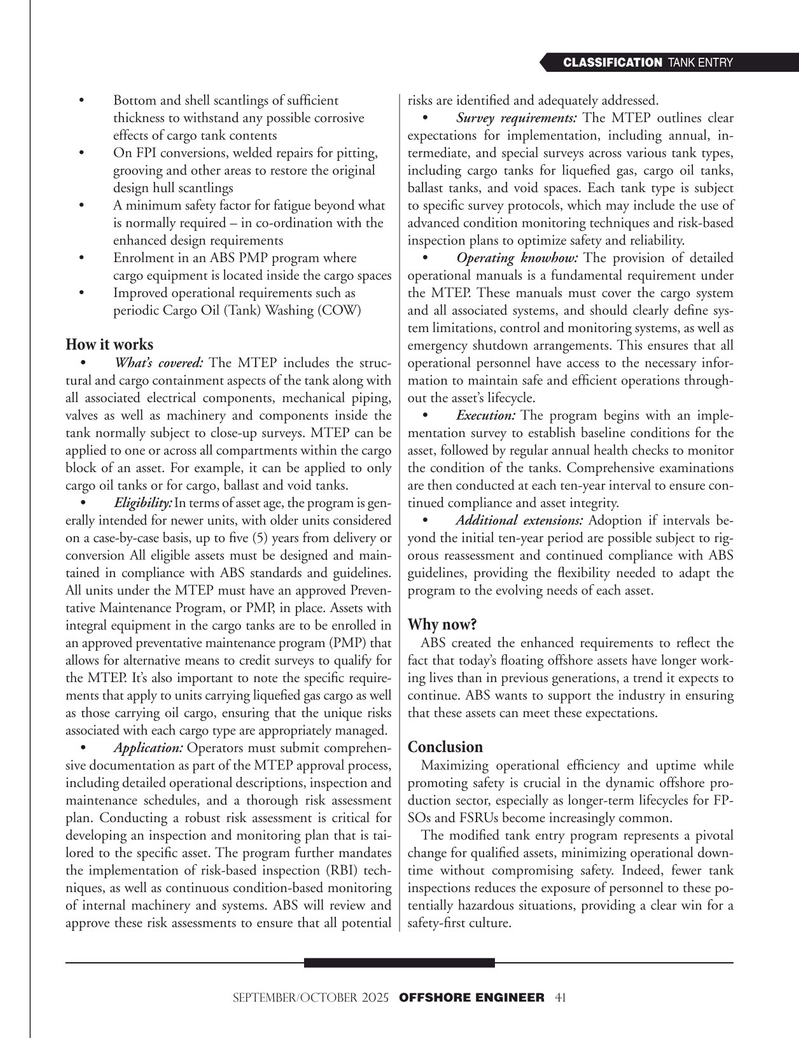
Page 41: of Offshore Engineer Magazine (Sep/Oct 2025)
Read this page in Pdf, Flash or Html5 edition of Sep/Oct 2025 Offshore Engineer Magazine
CLASSIFICATION TANK ENTRY • Bottom and shell scantlings of suffcient risks are identifed and adequately addressed.
thickness to withstand any possible corrosive • Survey requirements: The MTEP outlines clear effects of cargo tank contents expectations for implementation, including annual, in- • On FPI conversions, welded repairs for pitting, termediate, and special surveys across various tank types, gr ooving and other areas to restore the original including cargo tanks for liquefed gas, cargo oil tanks, design hull scantlings ballast tanks, and void spaces. Each tank type is subject • A minimum safety factor for fatigue beyond what to specifc survey protocols, which may include the use of is normally required – in co-ordination with the advanced condition monitoring techniques and risk-based enhanced design requirements inspection plans to optimize safety and reliability.
• Enrolment in an ABS PMP program where • Operating knowhow: The provision of detailed cargo equipment is located inside the cargo spaces operational manuals is a fundamental requirement under • Improved operational requirements such as the MTEP. These manuals must cover the cargo system periodic Cargo Oil (Tank) Washing (COW) and all associated systems, and should clearly defne sys- tem limitations, control and monitoring systems, as well as
How it works emergency shutdown arrangements. This ensures that all • What’s covered: The MTEP includes the struc- operational personnel have access to the necessary infor- tural and cargo containment aspects of the tank along with mation to maintain safe and effcient operations through- all associated electrical components, mechanical piping, out the asset’s lifecycle.
valves as well as machinery and components inside the • Execution: The program begins with an imple- tank normally subject to close-up surveys. MTEP can be mentation survey to establish baseline conditions for the applied to one or across all compartments within the cargo asset, followed by regular annual health checks to monitor block of an asset. For example, it can be applied to only the condition of the tanks. Comprehensive examinations cargo oil tanks or for cargo, ballast and void tanks. are then conducted at each ten-year interval to ensure con- • Eligibility: In terms of asset age, the program is gen- tinued compliance and asset integrity.
erally intended for newer units, with older units considered • Additional extensions: Adoption if intervals be- on a case-by-case basis, up to fve (5) years from delivery or yond the initial ten-year period are possible subject to rig- conversion All eligible assets must be designed and main- orous reassessment and continued compliance with ABS tained in compliance with ABS standards and guidelines. guidelines, providing the fexibility needed to adapt the
All units under the MTEP must have an approved Preven- program to the evolving needs of each asset.
tative Maintenance Program, or PMP, in place. Assets with integral equipment in the cargo tanks are to be enrolled in
Why now? an approved preventative maintenance program (PMP) that ABS created the enhanced requirements to refect the allows for alternative means to credit surveys to qualify for fact that today’s foating offshore assets have longer work- the MTEP. It’s also important to note the specifc require- ing lives than in previous generations, a trend it expects to ments that apply to units carrying liquefed gas cargo as well continue. ABS wants to support the industry in ensuring as those carrying oil cargo, ensuring that the unique risks that these assets can meet these expectations. associated with each cargo type are appropriately managed.
• Application: Operators must submit comprehen-
Conclusion sive documentation as part of the MTEP approval process, Maximizing operational effciency and uptime while including detailed operational descriptions, inspection and promoting safety is crucial in the dynamic offshore pro- maintenance schedules, and a thorough risk assessment duction sector, especially as longer-term lifecycles for FP- plan. Conducting a robust risk assessment is critical for SOs and FSRUs become increasingly common.
developing an inspection and monitoring plan that is tai- The modifed tank entry program represents a pivotal lored to the specifc asset. The program further mandates change for qualifed assets, minimizing operational down- the implementation of risk-based inspection (RBI) tech- time without compromising safety. Indeed, fewer tank niques, as well as continuous condition-based monitoring inspections reduces the exposure of personnel to these po- of internal machinery and systems. ABS will review and tentially hazardous situations, providing a clear win for a approve these risk assessments to ensure that all potential safety-frst culture.
SEPTEMBER/OCTOBER 2025 OFFSHORE ENGINEER 41

 40
40

 42
42